浅谈广告英语中双关语的运用_颜伟强
浅析英语双关语在广告中的运用及作用
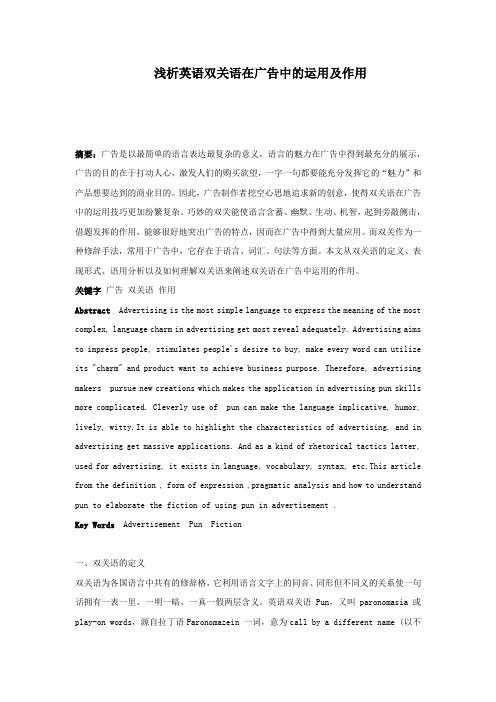
浅析英语双关语在广告中的运用及作用摘要:广告是以最简单的语言表达最复杂的意义,语言的魅力在广告中得到最充分的展示,广告的目的在于打动人心,激发人们的购买欲望,一字一句都要能充分发挥它的“魅力”和产品想要达到的商业目的。
因此,广告制作者挖空心思地追求新的创意,使得双关语在广告中的运用技巧更加纷繁复杂。
巧妙的双关能使语言含蓄、幽默、生动、机智,起到旁敲侧击,借题发挥的作用,能够很好地突出广告的特点,因而在广告中得到大量应用。
而双关作为一种修辞手法,常用于广告中,它存在于语言、词汇、句法等方面。
本文从双关语的定义、表现形式、语用分析以及如何理解双关语来阐述双关语在广告中运用的作用。
关键字广告双关语作用Abstract Advertising is the most simple language to express the meaning of the most complex, language charm in advertising get most reveal adequately. Advertising aims to impress people, stimulates people's desire to buy, make every word can utilize its "charm" and product want to achieve business purpose. Therefore, advertising makers pursue new creations which makes the application in advertising pun skills more complicated. Cleverly use of pun can make the language implicative, humor, lively, witty.It is able to highlight the characteristics of advertising, and in advertising get massive applications. And as a kind of rhetorical tactics latter, used for advertising, it exists in language, vocabulary, syntax, etc.This article from the definition , form of expression ,pragmatic analysis and how to understand pun to elaborate the fiction of using pun in advertisement .Key Words Advertisement Pun Fiction一、双关语的定义双关语为各国语言中共有的修辞格,它利用语言文字上的同音、同形但不同义的关系使一句话拥有一表一里、一明一暗、一真一假两层含义。
浅议广告英语双关语的理解
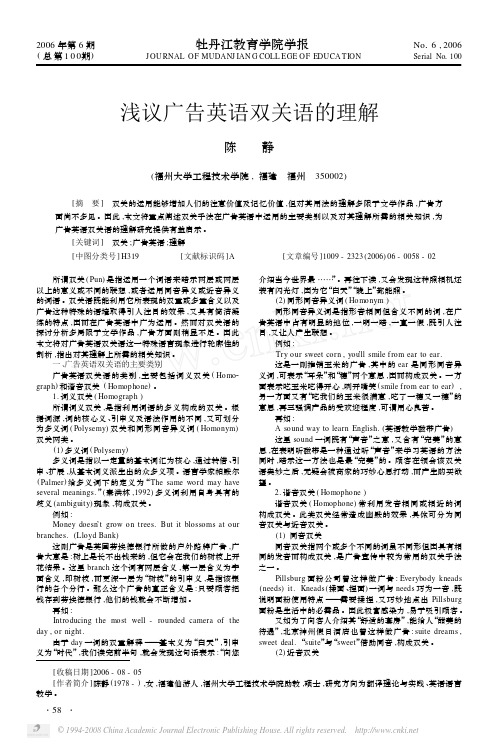
2006年第6期 牡丹江教育学院学报 No 16,2006(总第100期) J OU RNAL OF MUDANJ IAN G COLL EGE OF EDUCA TION Serial No 1100[收稿日期]2006-08-05[作者简介]陈静(1978-),女,福建仙游人,福州大学工程技术学院助教,硕士,研究方向为翻译理论与实践、英语语言教学。
浅议广告英语双关语的理解陈 静(福州大学工程技术学院,福建 福州 350002)[摘 要] 双关的运用能够增加人们的注意价值及记忆价值,但对其用法的理解多限于文学作品,广告方面尚不多见。
因此,本文将重点阐述双关手法在广告英语中运用的主要类别以及对其理解所需的相关知识,为广告英语双关语的理解研究提供有益启示。
[关键词] 双关;广告英语;理解[中图分类号]H319 [文献标识码]A [文章编号]1009-2323(2006)06-0058-02 所谓双关(Pun )是指运用一个词语来暗示两层或两层以上的意义或不同的联想,或者运用同音异义或近音异义的词语。
双关语既能利用它所表现的双重或多重含义以及广告这种特殊的语境取得引人注目的效果,又具有简洁凝练的特点,因而在广告英语中广为运用。
然而对双关语的探讨分析多局限于文学作品,广告方面则稍显不足。
因此本文将对广告英语双关语这一特殊语言现象进行轮廓性的剖析,指出对其理解上所需的相关知识。
一、广告英语双关语的主要类别广告英语双关语的类别,主要包括词义双关(Homo 2graph )和谐音双关(Homophone )。
1.词义双关(Homograph )所谓词义双关,是指利用词语的多义构成的双关。
根据词源,词的核心义、引申义及语法作用的不同,又可划分为多义词(Polysemy )双关和同形同音异义词(Homonym )双关两类。
(1)多义词(Polysemy )多义词是指以一定量的基本词汇为核心,通过转借、引申、扩展,从基本词义派生出的众多义项。
广告英语中双关语的运用及翻译
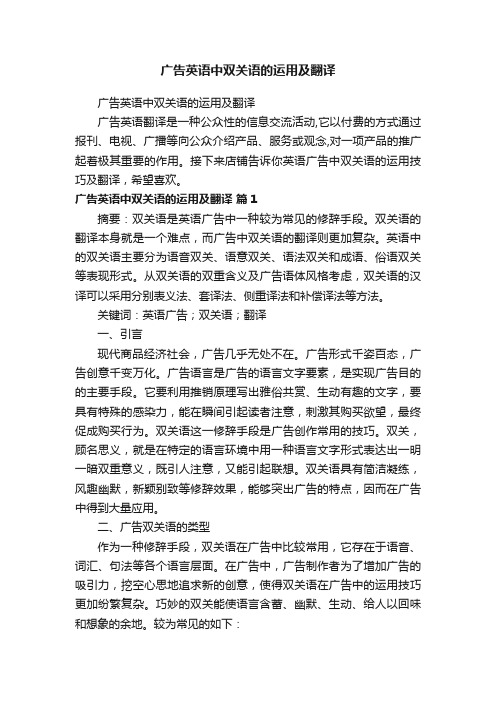
广告英语中双关语的运用及翻译广告英语中双关语的运用及翻译广告英语翻译是一种公众性的信息交流活动,它以付费的方式通过报刊、电视、广播等向公众介绍产品、服务或观念,对一项产品的推广起着极其重要的作用。
接下来店铺告诉你英语广告中双关语的运用技巧及翻译,希望喜欢。
广告英语中双关语的运用及翻译篇1摘要:双关语是英语广告中一种较为常见的修辞手段。
双关语的翻译本身就是一个难点,而广告中双关语的翻译则更加复杂。
英语中的双关语主要分为语音双关、语意双关、语法双关和成语、俗语双关等表现形式。
从双关语的双重含义及广告语体风格考虑,双关语的汉译可以采用分别表义法、套译法、侧重译法和补偿译法等方法。
关键词:英语广告;双关语;翻译一、引言现代商品经济社会,广告几乎无处不在。
广告形式千姿百态,广告创意千变万化。
广告语言是广告的语言文字要素,是实现广告目的的主要手段。
它要利用推销原理写出雅俗共赏、生动有趣的文字,要具有特殊的感染力,能在瞬间引起读者注意,刺激其购买欲望,最终促成购买行为。
双关语这一修辞手段是广告创作常用的技巧。
双关,顾名思义,就是在特定的语言环境中用一种语言文字形式表达出一明一暗双重意义,既引人注意,又能引起联想。
双关语具有简洁凝练,风趣幽默,新颖别致等修辞效果,能够突出广告的特点,因而在广告中得到大量应用。
二、广告双关语的类型作为一种修辞手段,双关语在广告中比较常用,它存在于语音、词汇、句法等各个语言层面。
在广告中,广告制作者为了增加广告的吸引力,挖空心思地追求新的创意,使得双关语在广告中的运用技巧更加纷繁复杂。
巧妙的双关能使语言含蓄、幽默、生动、给人以回味和想象的余地。
较为常见的如下:1.谐音双关谐音双关是用拼写相似,发音相同或相近的词构成的。
广告制作者非常乐于使用谐音双关,因为此类双关具有风趣、幽默、俏皮、滑稽的语言风格,能增强广告的说服力和感染力,从而给消费者留下深刻的印象。
(1)GoodbuyWinter!100%Cotton Knitwear $40这是一则冬季服装削价出售的广告。
浅谈广告英语中双关语的运用
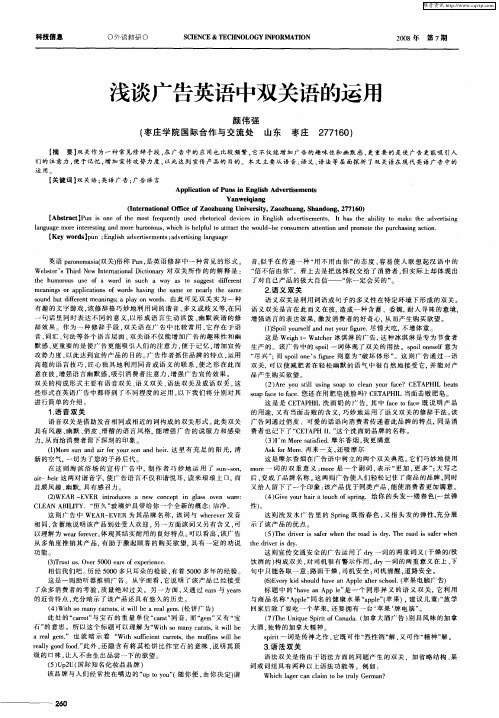
了对 自己产 品 的 极 大 自信— — “ 一 定 会买 的 ” 你 。 2语 义 双关 .
su db t iee t enns apa nw rs on u d rn m aig; lyo od、由此 可 见 双 关 实 为 一 种 f i 语 义 双 关 是 利 用 词语 或 句子 的 多 义性 在特 定 环境 下 形 成 的双 关 。 有 趣 的文 字 游 戏 , 修 辞 格 巧妙 地 利 用 词 的谐 音 、 义或 歧 义等 , 同 语 义 双关 是 言 在 此 而 义 在 彼 , 成 一 种 含 蓄 、委 婉 , 人寻 味 的意 境 。 该 多 在 造 耐 句 话 里 同时 表 达 不 同 的意 义 , 形 成 语 言生 动 活 泼 、 默 诙 谐 的修 增 强 语 言 的表 达 效果 。 发 消 费 者 的好 奇 心 , 而 产 生 购 买欲 望 。 以 幽 激 从 辞 效 果 。作 为 一 种 修 辞 手 段 。 关 语 在广 告 中 比 较 常 用 , 存 在 于语 双 它 ()piy u ef n o yu g r、 情 大 吃 , 1 ol o r ladnt o r u e 尽 S s i f 不增 体 重 。 音、 汇、 词 句法 等 各 个语 言层 面 。 关 语 不仅 能增 加 广 告 的 趣 味性 和幽 双 这 是 We ht : —Wace 冰 淇 淋 的广 告 。 种冰 淇 淋 是 专 为 节 食 者 g t r h 这
从功能对等角度浅析英语广告中双关语的运用和翻译策略

理论背景和发展
理论提出者:尤 金·A·奈达
理论核心:译文读 者对译文的反应与 原文读者对原文的 反应基本一致
发展历程:从词 汇对等到句法对 等到篇章对等, 再到功能对等
理论意义:为翻 译实践提供了重 要的理论指导和 实践依据
功能对等理论在翻译中的应用
定义:功能对等理 论强调译文与原文 在意义和风格上的 对等,而非形式对 等
注释法:在译文中 对原文中的双关语 进行注释,解释其 含义和文化背景, 以帮助读者更好地 理解原文
意译法
单击添加标题
意译法:根据原文的意思,用符合目标语表达习惯的词汇和句式进行翻 译,保留原文的意境和隐含意义,同时传达原文的文化内涵。
单击添加标题
直译法:保留原文的语言形式和文化意象,直接翻译原文的语义和表达 方式,同时注意保持原文的修辞效果和语言风格。
04
功能对等理论在双 关语翻译中的局限
性
Part One
功能对等理论概述
定义和原则
定义:功能对等理论是指翻译时不应追求文字表面的死 板对应,而应注重原文信息的准确传达和自然流畅的表 达。
原则:功能对等理论强调翻译时应遵循“忠实、通顺、 传神”的原则,即译文应忠实于原文,表达自然通顺, 并尽可能地传达原文的神韵和意境。
不断学习和更新知识:关注英语广告行业的最新动态和发展趋势,不断学习和更新知识,提 高自己的翻译水平。
灵活运用多种翻译方法和技巧
直译与意译相结合:根据原文语境和语义,选择合适的翻译方法
语义对等与文化对等并重:关注原文的文化内涵,确保译文传达出相同的文化信息
注重语言美感:在保持原文意义的基础上,运用修辞手法增强译文的表达效果 遵循广告语言特点:保持广告语言的生动、简洁和富有感染力,避免生硬翻译
浅析英语广告中双关语的运用及翻译 英文

1. IntroductionAdvertising is a kind of mass media, its final purpose is to spread information and change the attitude of consumers, induce consumers to buy the products, and thereby the advertisers get the profits.1The basis of advertising language are concise, lively, and imaginative that be taken the central position. Advertising makes use of promote principle and draws up the vivid and interesting pictures and words to arouse the consumers’ attention s in the twinkling of an eye, stimulates the readers desire to get in on your offer. Modern society is a commercial economy, advertisements are everywhere. Forms of advertisements are varied and the rhetorical devices of advertisements are plentiful: personification, antithetical parallelism, exaggeration, contrast, parallelism, rhymes, and pun provides the artistic aesthetic feeling to the readers.The pun, in Italian, “punctilio” means “a fine point,” hence a verbal quibble, and is most likely the source of the English punctilious. pun is defined by Webste r as “the humorous use of a word, or of words which are formed or sounded alike but have different meanings, in such a way as to play on two or more of the possible application; a play on words.”2 Pun is a skill that always been used in the creative work of advertisements. It can express the double meaning in the particular language environment, the bright and shadow mutual effect arouse the readers’interest and imaginations. Pun is concise, humorous and novel, can give room for thinking that been favored by large numbers of advertisements. So the application of puns in English advertisements and its translation are very important.Though more and more scholars do research on pun’s translation now, their researches are mainly about translation strategies and they rarely aim at dealing with barriers of translating puns particularly about a lot of detailed examples. Thus, this thesis is to discuss the cultural and linguistic barriers in pun translation through some examples, and the application of puns and its translation. Then several translation methods have been proposed in solving the problems in translating puns from English to Chinese.This thesis could also enable readers to have a better understanding of the functions of puns in advertisements as well as their crucial roles in advertisements.1孙晓丽,《广告英语与实例》(北京:中国广播电视出版社,1995),3-4。
探究英语广告中双关语的使用方法
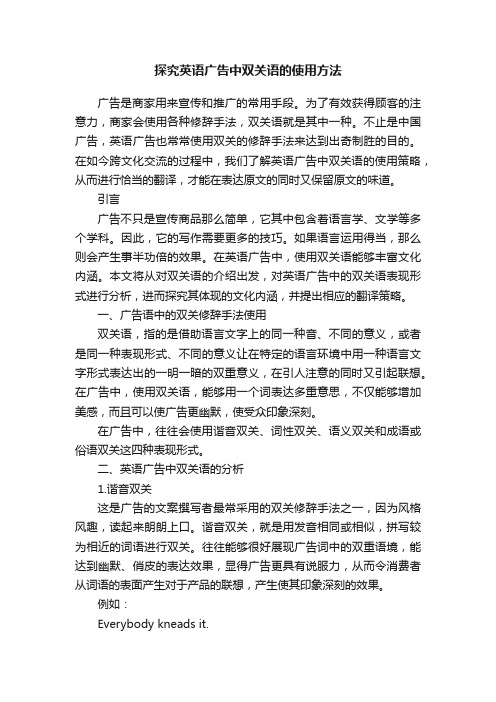
探究英语广告中双关语的使用方法广告是商家用来宣传和推广的常用手段。
为了有效获得顾客的注意力,商家会使用各种修辞手法,双关语就是其中一种。
不止是中国广告,英语广告也常常使用双关的修辞手法来达到出奇制胜的目的。
在如今跨文化交流的过程中,我们了解英语广告中双关语的使用策略,从而进行恰当的翻译,才能在表达原文的同时又保留原文的味道。
引言广告不只是宣传商品那么简单,它其中包含着语言学、文学等多个学科。
因此,它的写作需要更多的技巧。
如果语言运用得当,那么则会产生事半功倍的效果。
在英语广告中,使用双关语能够丰富文化内涵。
本文将从对双关语的介绍出发,对英语广告中的双关语表现形式进行分析,进而探究其体现的文化内涵,并提出相应的翻译策略。
一、广告语中的双关修辞手法使用双关语,指的是借助语言文字上的同一种音、不同的意义,或者是同一种表现形式、不同的意义让在特定的语言环境中用一种语言文字形式表达出的一明一暗的双重意义,在引人注意的同时又引起联想。
在广告中,使用双关语,能够用一个词表达多重意思,不仅能够增加美感,而且可以使广告更幽默,使受众印象深刻。
在广告中,往往会使用谐音双关、词性双关、语义双关和成语或俗语双关这四种表现形式。
二、英语广告中双关语的分析1.谐音双关这是广告的文案撰写者最常采用的双关修辞手法之一,因为风格风趣,读起来朗朗上口。
谐音双关,就是用发音相同或相似,拼写较为相近的词语进行双关。
往往能够很好展现广告词中的双重语境,能达到幽默、俏皮的表达效果,显得广告更具有说服力,从而令消费者从词语的表面产生对于产品的联想,产生使其印象深刻的效果。
例如:Everybody kneads it.这是面粉公司的一则广告,广告商考虑到面粉是家庭的生活必需品,所以将knead(揉面)与need(需要)进行谐音双关,在用knead(揉面)呈现面粉的特性的同时,巧妙的表达了“人人都需要它”的意思。
作为消费者,能够很好的通过这两个英语单词的谐音双关记住这个广告。
广告英语中的双关修辞运用
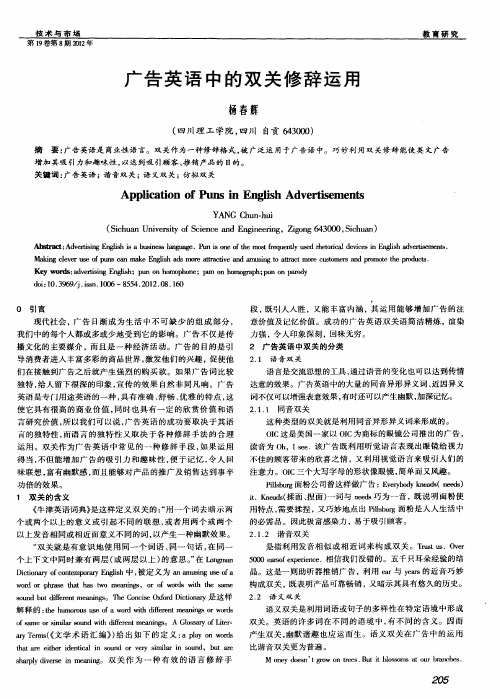
教 育 研 究
Vo . 9 1 1 No. 2 2 8, 01
( l dB n ) Lo a k y
译文: 并非所有 的汽车 生来 就是平 等 的。这是 日本 三菱 汽车广告用语 , 源于美 国独立 宣言 中的“ lm naec a de Al e r r t . e e u 1( qa.人 生来 就是平 等的) 。这则 广告就 是将 名句 改头换 面 , ” 以人们已有的知识 为源 泉 , 用词 上做一 个小 小 的而又关 键 在 的变异 , 就形 成了引人注意的突出作用。
0 引 言
段, 既引人人胜 ,又能 丰富 内涵 ,其运 用能 够增 加广告 的注 意价值及记忆价值 。成 功 的广 告英语 双关语 简洁精 炼 ,渲染 力强, 令人印象深刻 ,回味无穷 。
2 广 告 英 语 中 双 关 的 分 类
2 1 语 音 双 关 .
现代社会 , 告 日渐 成 为生 活 中不 可缺 少 的组 成 部分 , 广 我们 中的每个人都或 多或 少地受 到它 的影 响 。广告 不仅是 传
播 文化 的主要 媒介 ,而且 是一 种经济 活动 。广 告 的 目的是 引 导消费 者进 入丰 富多彩的商品世界 , 激发他们 的兴趣 , 促使他 们在接触 到广告之后 就产生强烈 的购买 欲 。如果 广告 词 比较 独特 , 给人 留下很 深的 印象 , 宣传 的效果 自然非 同凡 响。广告 英语是 专门用途英语 的一种 , 具有准 确 、 畅 、 舒 优雅 的特点 , 这
Ke y wor : d e t i gih; p n n o o h n ds a v ri ng En ls s u o h m p o e; p n o mo rp p n o a o y u n ho ga h; u n p rd
英语广告语中的双关语
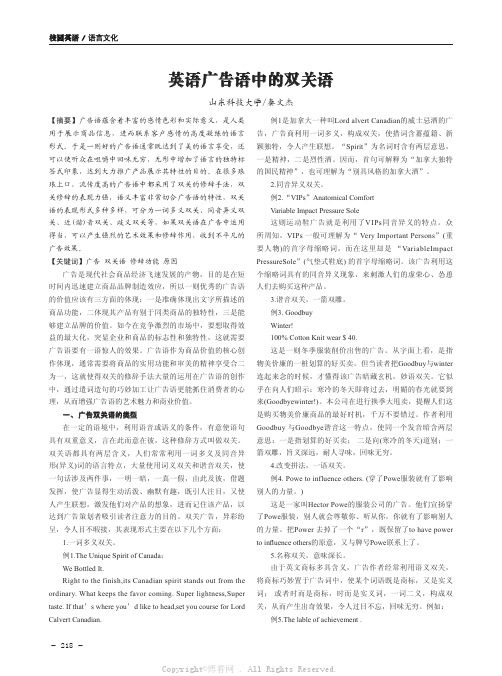
- 218-校园英语 / 语言文化英语广告语中的双关语山东科技大学/秦文杰【摘要】广告语蕴含着丰富的感情色彩和实际意义,是人类用于展示商品信息,进而联系客户感情的高度凝练的语言形式。
于是一则好的广告语通常既达到了美的语言享受,还可以使听众在咀嚼中回味无穷,无形中增加了语言的独特标签式印象,达到大力推广产品展示其特性的目的。
在很多琅琅上口,流传度高的广告语中都采用了双关的修辞手法,双关修辞的表现力强,语义丰富非常切合广告语的特性,双关语的表现形式多种多样,可分为一词多义双关、同音异义双关、近(谐)音双关、歧义双关等,如果双关语在广告中运用得当,可以产生强烈的艺术效果和修辞作用,收到不平凡的广告效果。
【关键词】广告 双关语 修辞功能 原因广告是现代社会商品经济飞速发展的产物,目的是在短时间内迅速建立商品品牌制造效应,所以一则优秀的广告语的价值应该有三方面的体现:一是准确体现出文字所描述的商品功能,二体现其产品有别于同类商品的独特性,三是能够建立品牌的价值。
如今在竞争激烈的市场中,要想取得效益的最大化,突显企业和商品的标志性和独特性,这就需要广告语要有一语惊人的效果。
广告语作为商品价值的核心创作体现,通常需要将商品的实用功能和审美的精神享受合二为一,这就使得双关的修辞手法大量的运用在广告语的创作中,通过遣词造句的巧妙加工让广告语更能抓住消费者的心理,从而增强广告语的艺术魅力和商业价值。
一、 广告双关语的类型在一定的语境中,利用语音或语义的条件,有意使语句具有双重意义,言在此而意在彼,这种修辞方式叫做双关。
双关语都具有两层含义,人们常常利用一词多义及同音异形(异义)词的语言特点,大量使用词义双关和谐音双关,使一句话涉及两件事,一明一暗,一真一假,由此及彼,借题发挥,使广告显得生动活泼、幽默有趣,既引人注目,又使人产生联想,激发他们对产品的想象,进而记住该产品,以达到广告策划者吸引读者注意力的目的。
双关广告,异彩纷呈,令人目不暇接,其表现形式主要在以下几个方面:1.一词多义双关。
英语电视广告中双关语的运用技巧及翻译
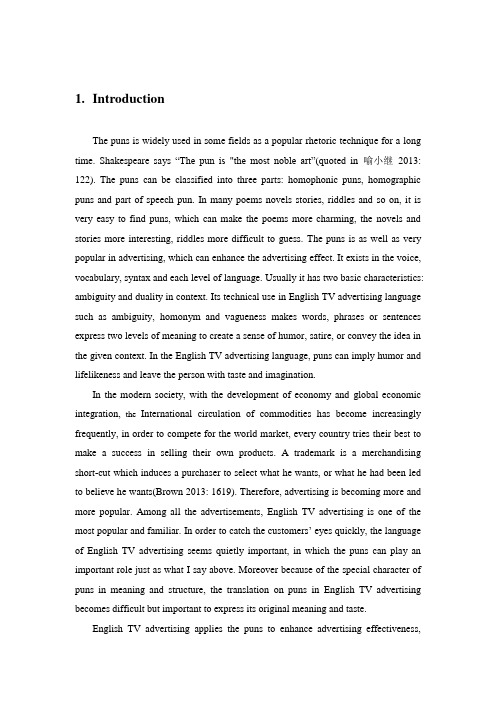
1. IntroductionThe puns is widely used in some fields as a popular rhetoric technique for a long time. Shakespeare says “The pun is "the most noble art”(quoted in 喻小继2013: 122). The puns can be classified into three parts: homophonic puns, homographic puns and part of speech pun. In many poems novels stories, riddles and so on, it is very easy to find puns, which can make the poems more charming, the novels and stories more interesting, riddles more difficult to guess. The puns is as well as very popular in advertising, which can enhance the advertising effect.It exists in the voice, vocabulary, syntax and each level of language. Usually it has two basic characteristics: ambiguity and duality in context. Its technical use in English TV advertising language such as ambiguity, homonym and vagueness makes words, phrases or sentences express two levels of meaning to create a sense of humor, satire, or convey the idea in the given context. In the English TV advertising language, puns can imply humor and lifelikeness and leave the person with taste and imagination.In the modern society, with the development of economy and global economic integration,the International circulation of commodities has become increasingly frequently, in order to compete for the world market, every country tries their best to make a success in selling their own products. A trademark is a merchandising short-cut which induces a purchaser to select what he wants, or what he had been led to believe he wants(Brown 2013: 1619). Therefore, advertising is becoming more and more popular. Among all the advertisements, English TV advertising is one of the most popular and familiar. In order to catch the customers’ eyes quickly, the language of English TV advertising seems quietly important, in which the puns can play an important role just as what I say above. Moreover because of the special character of puns in meaning and structure, the translation on puns in English TV advertising becomes difficult but important to express its original meaning and taste.English TV advertising applies the puns to enhance advertising effectiveness,catch public’s attention and deliver unique significance, so how to use it and how to translate it become quite important. According what just said, the paper states the theme from three aspects. Firstly, it introduce the features and functions of puns in English TV advertising. Secondly, it elaborates the application of puns in English TV advertising. Finally, it looks at the translation of puns in English TV advertising.2. The punsPun is the mostly widely used in English TV advertising as a rhetoric method. Pun is a humors use of a word phrase or sentence that has two meanings or different words that sound the same. When it is used in English TV advertising, it will color its effect. If the puns is used properly, it can produce very important artistic result and rhetorical function in advertising(zhao 2003: 56)2.1The definition of punsThe pun is a word game,originated from the Latin word paronomasia, which means calling by a different name(ibid.).The definition of Puns in the Oxford English dictionary is the use of a word in such a way as to suggest two or more meanings or different associations,or the use of two or more words of the same or nearly the same sound with different meanings, so as to produce a humorous effect. The Merriam Webster Dictionary shows the definition of pun is the humorous use of a word in a way that suggests two or more interpretations. In the view of all kinds of definitions, a pun is a form of word play which suggests two or more meanings, by exploiting multiple meanings of words, or of similar-sounding words, for an intended humorous or rhetorical effect. Pun is defined differently in different purpose, All in all, in different particular purpose, in different situation, pun shows different effects.2.2The functions of puns in English TV advertisingWhen the puns is used in English TV advertising, in can produce surprising effect such as the function of persuasion, the function of economic value, The function of creativity.Advertising has a high requirement for language, which should impress someone who just have a glance at it. This is the first step to attract customers to pay attention to the product. The second step is that when the advertising impress her or him very much, the customers will go into the products deeply to seek more information about it. Then it will bring good news for the sellers. Finally if the advertisement is attractive enough, it would persuade customers to purchase. For example: here is an English TV advertisement of shampoo, Give your hair a touch of spring. In this advertisement, it makes the pun of the word spring. One is as a none and the other is as an adjective. From it, we can easily conclude the idea that their shampoo would make your hair like spring— newborn and vigor. When I first got this advertisement, suddenly a sense of comfort came to my mind and there is beautiful natural scenery in front of my eyes. Pun in this advertisement is effective and powerful.Nowadays more and more merchants are apt to expand consumer awareness through a targeted advertising campaign. So the application of puns in English TV advertising benefits the businessmen very much. For instance, Emart—translated into Chinese name is 易买得. It is short and clear and it is easy to pronounce and remember. In which the letter E indicates different meanings, such economy, easy, environment, energy, etc. which can stand for the character of the supermarket. The rest letter combined mart stands for supermarket. This word leaves the public room for imagination that this supermarket is trustworthy and the price of the product is fair. At the same time it leaves the customers the belief that the service here if friendly.The application of puns in English TV advertisement is always flexible, which can give us much surprise. The creativity in the application of pun would present the distinctive features of a brand. So during the creation of one advertisement, in order tobe better to take attention, the new words in some slogan will be created.3.The application of puns in English TV advertisingIn the advertising language, people pay more and more attention to the use of rhetoric means by using the refining, accurate and vivid language, which can make the advertisement more attractive and can expand the popularity of the brand and the sales of the products. A rhetorical figure can be defined as an artful deviation in the form taken by a statement(McQuarrie and Mick 1996: 424). Therefore, it is common to find that the pun is widely used in advertising. The puns according its characters can be classified into three kinds in English TV advertising: homophonic puns, homographic puns and part of speech pun.3.1Homophonic punThe homophonic pun, a common type, utilize the exploitation of word pairs which sound alike but are not synonymous. A homophonic pun exploits words which are spelled the same but possess different meanings and sounds. Because of their nature, they rely on sight more than hearing, contrary to homophonic puns. They are also known as heteronymic puns.For example, here is an advertising of telephone, Make your every hello a real good-buy. In this advertisement, the author makes the pun of good-buy and good-bye neatly, which make the advertisement wit and wisecracking. From the beginning hello to the end of the call good-bye, it can transmit every message faithfully to each other, which let relatives and friends no matter where they are can receive each other's concern and greetings by the telephone. The business catch that to impress the advertising to the hearts of the consumers’, aimed to achieve its business purpose. Moreover the word good-buy contains the meaning of high quality and inexpensive, so the consumers will have such psychology that I bought this phone is definitelyvalue for the money.3.2Homographic punHomonymic puns, another common type, arise from the exploitation of words which are both homographs and homophones. A homonymic pun may also be polysemic, in which the words must be homonymic and also possess related meanings, a condition which is often subjective. However, lexicographers define polysemes as listed under a single dictionary lemma which homonyms are treated in separate lemmata.For instance, this is the advertising of 7-up in the United States, Fresh up with 7-up. The number 7 is a lucky number in western countries. During gambling, the dice 7 is the winner. And up means come up with. It also means Lively up, make a person sober. At the same time, the 7-up is the brand of the drink. All of these characters make this advertisement read sonorous, forceful and full of rhythm as well as easy to understand.3.3part of speech punPOS pun is mainly due to changes caused by part of speech. Every word usually has two or more than two kinds of parts of speech. Used this property, the advertisement has the effect of puns, making the advertising language more concise, condensed, humorous and witty.An example may make the point clear. Coke refreshes you like no other can. This is an advertisement of cans of coke. The producer makes the pun of the word can. It not only can be seen as a modal verb ellipsis in (can refresh you), but also can be understood as canned drinks, in this situation, can means tin.4.The translation of puns in English TV advertisingAdvertising language is a kind of refined, subtle, expressive and loaded language. There are double meanings in the expression of the pun in English TV ad. In the pun’s language structure and expression, there is an insurmountable obstacle in translation. Besides, the use of advertising puns in a foreign language class forces a teacher to address a thorny issue: that is, whether or not the advertising of a given culture adequately or accurately reflects the values and traditions native to that culture(Berg 1987: 684). So the translation should be based on the content and characteristics of advertisement, and then we should choose the appropriate Chinese expressions. Not only should we take full care of the style of the original text, but also the translation should convey the original information. Only in this way, can the translation be successful.4.1 Division translationThis is an advertisement of cigarette, I’m More satisfied. Ask for More. This is a model in the use of pun. It is very clever to use the two meanings of word more. More is an adverb. When m becomes capital, it is a name of a brand. These two advertisements not only make it easy for people to remember the brand, but also leave the consumers an impression: the product is superior to the similar products, which can make the consumer satisfied. We translated it into “摩尔香烟,我更满意”;“再来一支,还吸摩尔”.In this translation, Punning semantic is split into two layers respectively expressed in the translation. It is easy to read with four words.However, it is worth pointing that although this translation method keeps the double meaning of pun, loses the kind of conciseness, the charm of witty and the two meanings of a word.4.2 Major translationWhen it is difficult to give the two kinds of meanings in the given language, we must make a choice. According to the basic requirement, it is necessary to choose the surface meaning or the deep meaning.The driver is safer when the road is dry;The road is safer when the driver is dry.The traffic safety advertisement uses the double meanings of the word "dry". One is no water, the other is no drinking. When translated, a dual meaning the word dry in the sentence can only be taken one: 路面干燥,司机安全;司机清醒,道路安全.4.3 Free translationChinese and Western cognitive environment varies very much. Using retention strategy sometimes will mislead and make negative influence. Thus it is necessary to translate in free style sometimes.Easier dusting by a stre - e - etch!This is an advertising of Stretch dust cloth, its spelling and pronunciation because of the hyphen become longer. It means its products of good elasticity and clean power. We translate it into拉拉拉长,除尘力强。
英语双关语在广告中的应用及翻译

语音双关又叫渚音双关,由拼写相似,发 音相同或相近的词语构成,它以语音为纽带, 将两个毫不相关的词联系在一起,使观赏者通 过联想领悟其幽默感。此类双关风趣、俏皮、滑 稽。如:
(1)MaJ‘e your every he【lo
a
进行q11 这足一则商家削价的广告,仿拟的足谚语 “one。8 meaIis another man’8 poi80n.(甲之佳肴, 乙之毒药)”。 2.双关在广告英语中的翻译 英语广告中双关的翻译应根据广告内容 与特点,既要亢分照顾原文的滔体风格以及不 同文化中存在的不同语意表述,义要尽量传达 原文的信息。在翻泽方法上,直译与意译一直 是翻译界争论的焦点。对于广告英语中双天的 翻泽,府采『fJ辩证翻洋法,即直泽与意泽的结 合,在顾及语法特征的同时,又避免信息量的 流失。总体束说,在翻译时多使川简单句,少用 复合句;频繁使用疑问句,巧用祈使句。以下主 要是针对广告英语中双戈的几点翻泽方法。 2.1翻泽时,可以根据语意适当的增添词 句,使句意通顺。便于理解。 (1)Impossihle m“le possi}】1e.(使不可能变 为可能。)(佳能打印机) 这显然是省略结构,在语法上几乎不成 立,可它传达的含义却很明白:把不可能的变 成可能的。考虑到句巾成分的语法功能,此句 可理解为:111e imp08sihle e¨be f11ade p0自8ihle
E∞ier du slIngby
a
烟广告中。mds就具有了双重意义:动词“结 束”和名词“香烟蒂”。这句香烟广告词可以套 用原来成语的翻译模式.译成“烟蒂好,烟就
好”。 (2)Beller 1ale th∞t}1e lafe.
这一妙句出自成语“Befter late th∞never” (晚来总比不来好)。它妙就妙在不仅引用了成 语的结构,还利用了late的双关意义.Ihe laIe 这里指the dt划。双关的运用使这则交通公益 广告产生了强大的震撼力。其译文可套译为 “迟到总比丧命好”。 总之,双关手法在广告写作中具有重要的 作用,它口I以表达更为丰富、深厚的内容,传达 更为广博的信息,从而使广告最大程度地起到 宣传、介绍的作用,使广告既能介绍公司和商 品的特点,又能给人以美感、智慧,让人轻松愉 快,过目难忘,同时还能感受企业的文化精神 与责任感。 参考文献: 【1】李庆荣.现代实用汉语修辞【MHE京;北 京大学出版社。2()02:252. 【2】王涛粱景会.广告英语的修辞特点及 翻译策略探讨们.南昌高专学报,2()09,(4):65. 【3】胡一.广告英语的修辞魅力们.英语学
浅析英语广告中双关语的使用

- 230-校园英语 / 语言文化研究浅析英语广告中双关语的使用河南省工艺美术学校/袁方方【摘要】广告对于产品来说可以起到很好的宣传、推广效应,能够促使人们对产品予以深入了解。
在英语广告中通过双关语的应用不仅可以达到很好地诙谐幽默作用,而且能够让人记忆深刻。
基于此,本文就英语广告中双关语的使用进行分析研究,以供参考。
【关键词】英语广告 双关语 应用分析一、英语双关语的特点和修辞功能在英文国家的各种书籍文体中,双关语从不是独立存在,而是相辅相承的。
借助英语独有的特点与历史文化背景,这一修辞手段被广泛运用在广告中,来表现幽默、含蓄、讽刺等内涵,其效果形象而生动、意味独特而深长,能使商品充满人性化的感情色彩,提高消费人群对广告及其商品的兴趣,增强消费者消费信心,有利于商品销售。
二、双关语在广告中的运用1.在广告中使用谐音相关。
谐音双关多是用拼写相似、发音相同或相近的词构成的,主要侧重在发音或拼写上,利用词的同音或近音的特点,一语双关地表达广告主题所要表达的意思,这种谐音双关的修辞方式易用且充满幽默感,利用同音或近音听觉特点,使人听起来可产生两种截然不同的含义,即构成了双重意义,这样就使得一句话中包含两件事情或两种内容。
比如,Seven days without water makes one weak.巧妙地套用了Seven days make one week这个人所共知的句子,利用weak和week同音的条件获得幽默的效果。
再如,During the two previous centuries musical styles went in one era and out of another…利用era(时代)和ear(耳朵)发音相似的条件,使人很容易联想到英语成语:“wentin one ear and out of another”(左耳进右耳出,听了就忘),使全句具有新意。
One man’s Mede is another man’s Persian.一句中Mede和meat(食物)发音近似,在由成语的上半句“One man’s meat”诱导出相处成语的下半句“another man’s poison”。
英语广告中双关语的运用及翻译
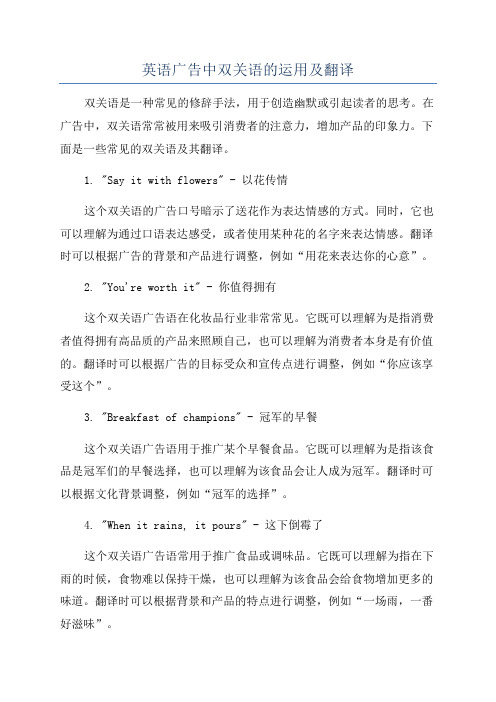
英语广告中双关语的运用及翻译双关语是一种常见的修辞手法,用于创造幽默或引起读者的思考。
在广告中,双关语常常被用来吸引消费者的注意力,增加产品的印象力。
下面是一些常见的双关语及其翻译。
1. "Say it with flowers" - 以花传情这个双关语的广告口号暗示了送花作为表达情感的方式。
同时,它也可以理解为通过口语表达感受,或者使用某种花的名字来表达情感。
翻译时可以根据广告的背景和产品进行调整,例如“用花来表达你的心意”。
2. "You're worth it" - 你值得拥有这个双关语广告语在化妆品行业非常常见。
它既可以理解为是指消费者值得拥有高品质的产品来照顾自己,也可以理解为消费者本身是有价值的。
翻译时可以根据广告的目标受众和宣传点进行调整,例如“你应该享受这个”。
3. "Breakfast of champions" - 冠军的早餐这个双关语广告语用于推广某个早餐食品。
它既可以理解为是指该食品是冠军们的早餐选择,也可以理解为该食品会让人成为冠军。
翻译时可以根据文化背景调整,例如“冠军的选择”。
4. "When it rains, it pours" - 这下倒霉了这个双关语广告语常用于推广食品或调味品。
它既可以理解为指在下雨的时候,食物难以保持干燥,也可以理解为该食品会给食物增加更多的味道。
翻译时可以根据背景和产品的特点进行调整,例如“一场雨,一番好滋味”。
5. "Life's a journey, enjoy the ride" - 人生是一场旅程,享受骑行吧这个双关语广告语常用于推广交通工具或旅游产品。
它既可以理解为是指人生是一段旅程,要享受其中的乐趣,也可以理解为指通过骑行来享受生活的方式。
翻译时可以根据广告的背景和产品进行调整,例如“人生如旅,快乐骑行”。
总体而言,双关语在英语广告中被广泛使用,因为它能够吸引消费者的注意力,增加广告的趣味性和记忆力。
英语广告中双关语的运用及翻译
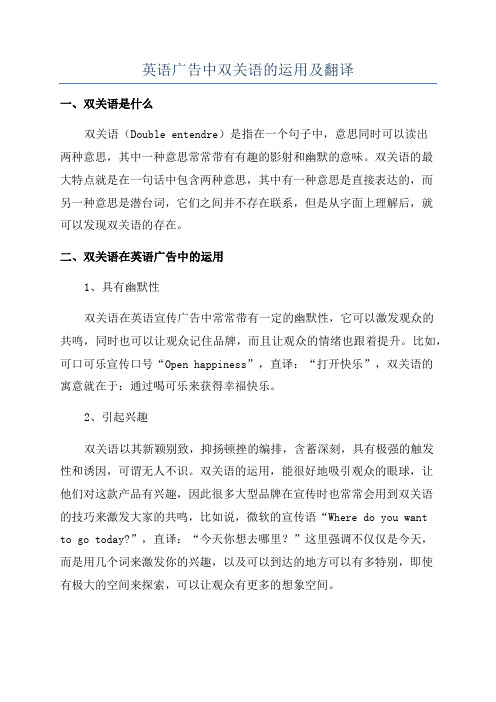
英语广告中双关语的运用及翻译
一、双关语是什么
双关语(Double entendre)是指在一个句子中,意思同时可以读出
两种意思,其中一种意思常常带有有趣的影射和幽默的意味。
双关语的最
大特点就是在一句话中包含两种意思,其中有一种意思是直接表达的,而
另一种意思是潜台词,它们之间并不存在联系,但是从字面上理解后,就
可以发现双关语的存在。
二、双关语在英语广告中的运用
1、具有幽默性
双关语在英语宣传广告中常常带有一定的幽默性,它可以激发观众的
共鸣,同时也可以让观众记住品牌,而且让观众的情绪也跟着提升。
比如,可口可乐宣传口号“Open happiness”,直译:“打开快乐”,双关语的
寓意就在于:通过喝可乐来获得幸福快乐。
2、引起兴趣
双关语以其新颖别致,抑扬顿挫的编排,含蓄深刻,具有极强的触发
性和诱因,可谓无人不识。
双关语的运用,能很好地吸引观众的眼球,让
他们对这款产品有兴趣,因此很多大型品牌在宣传时也常常会用到双关语
的技巧来激发大家的共鸣,比如说,微软的宣传语“Where do y ou want
to go today?”,直译:“今天你想去哪里?”这里强调不仅仅是今天,
而是用几个词来激发你的兴趣,以及可以到达的地方可以有多特别,即使
有极大的空间来探索,可以让观众有更多的想象空间。
英语广告中双关的应用及其翻译浅谈论文三稿3.1

1. IntroductionIn a certain context, a word or a phrase that is relevant to two conceptions, feelings or ideas are often used to make an expression more humorous or effective. The humorous or effective expression is achieved when there is similarity or identity between certain words in such aspects as pronunciation (sound), formation or meaning. The similarity or identity enables people to connect naturally the external meaning with the implication. This is what we call the use of puns. As early as 2000 years ago, the use of puns was accepted in certain styles. And from then on, numerous puns were created through the creative and ingenious works of both Chinese and English writers.With the development of the economy and technology, the globe has been becoming much smaller than before day by day. And with the enforcement of an open foreign policy, the relations between China and other countries have become more and more close. Therefore, advertisement plays a very important role when one wants to open a big market in foreign countries for his products. Pun, as a usual kind of rhetorical device, the translation of which has been regarded as a really hard task. And whether it can be translated or not has been hotly debated among the scholars until the famous American translator Eugene Nida stated the theory Functional Equivalence. It means that when one translates a text from one language to another, both two languages should be equal on the function of conveying the same meaning to readers, but not on the formation of the words. And the content in one language certainly can be conveyed relatively precise into another language. This theory gives a new birth to the translation of pun.While we still have many problems and difficulties that should be figured out and we also have the difficulties to find out the best way to translate puns in ads. Every language has its own specific characteristics. Language difference often exists in such aspects as pronunciation, words and figures of speech. All of these inevitably lead to correspondent vacancy in translation between two languages. So the rhetoric devices such as puns, alliterations and so on become the difficult points in translation because of their cultural and linguistic characteristics. Pun is a witticism, which is concise and effective. It involves the use of a word with more than one meaning, or it involves the use of words that have the same or nearly the same sound but different meanings. Due to the phonological or lexical vacancy between the source and targetlanguage, a pun, when translated into a target language, may not necessarily result in another pun, though it is sometimes possible. This is exactly why the translation of puns is thought of as a difficult point.However, we shall recognize the fact with no intention of being pessimistic to the translatability of puns, though the barrier in translation exists as long as social and cultural differences exist. One thing is for sure that there is no source text that absolutely cannot be translated in the target one. There is translatability to some extent when we come across a pun that that is usually regarded as “untranslatable". It is possible for us to make some compensation in translation to try to convert the untranslatability into translatability. So, we should have the idea that the translation of a pun is possible to a certain extent.In some but few cases, the original version can be translated literally or directly into the target language with the referential meanings are retained in the version. To retain such puns, it depends on the coincident correspondence in pronunciation or word meaning between the source and target languages. And it also depends on the translators who have required a good mastery of both languages as well as the techniques of translation. The embodiment of the linguistic meaning of puns, together with the pragmatic equivalent effect of the source language, is the ideal translation that we should pursue. While in many more cases, it is hard for us to retain the linguistic meaning in puns, and this is also the persistent ailment in the translation of puns. So if it is possible, the translators maybe can turn to other rhetoric means and use them as compensation for the linguistic meaning. In this way, while the referential meaning and pragmatic meaning can be conveyed, the linguistic meaning is also expressed though it is done in another way.The thesis begins with the definition of puns and its classification, then the author tries to illustrate the important functions and the side effects that puns may cause in ads. With the guidance of Eugene Nida's theory of Functional Equivalence, the author proceeds to deal with devices of translating puns. And at last the author will make a conclusion.2. Literature ReviewIn this section, a comprehensive review is made to review the history and data of the pun and its translation in English advertising. It mainly includes four parts: definition andclassification of puns, effect of puns in English ads, translatability of puns and criterion of translating puns.2.1 Definition and classification of punsPun is defined in The Concise Oxford Dictionary as "humorous use of word to suggest different meanings, or of word of same sound with different meanings; play on words". In The Oxford English Dictionary, pun is defined as "the use of word in such a way as to suggest two or more meanings or different associations, or the use of two or more words of the same or nearly the same sound with different meanings, so as to produce a humorous effect". In Longman Dictionary of the English Language, pun is defined as "a witticism, involving the use of a word with more than one meaning, or of words having the same, or nearly the same sound but different meanings".In "The Varieties and Translation of English Puns", the author Xu Zhongbing states that puns can be roughly divided into two parts. They are named paronomasia(谐音双关)and antalaclasis(一词两义双关). Paronomasia is the use of two words that are the same or similar in sound but different in meaning. For instance, "A bald man drew rabbits on his head. He thought that from a distance they might look hares (hairs). "(牟丽:2002,78)"hare” means rabbits, and it is pronounced the same with the word "hair". The use of them makes the sentence humorous and very interesting. As for "antalaclasis", it refers to by using a word but to express more than one meaning. For example, the famous novelist Ernest Hemingway wrote a famous novel in 1927 which is named "Farewell, Arms"(永别了,武器). The word "arm" has two meanings, one refers to the weapons for war, such as guns and so on; the other one refers to hug, has the connotation of love. Thus, the word "arm" expresses the two themes in the book.The classification given above is not so specific. In the book English Writing and Rhetoric which is written by Professor Wen Jun gives us a much more specific means of classification. And it gives us four categories of puns:homophnic puns(同音双关), paronomasia(谐音双关), Antalaclasis (一词异义双关) and sylleptic puns(一词多义双关).2.2 Persuasive Effect of Puns in English Ads and Its Side EffectAs the puns in English ads are more and more frequently employed, the effect of puns attracts our more and more attention. In this part, both positive and negative effects are discussed. Many advertisers make use of puns in ads in order to persuade people to buy their products andservices. While spending money is a serious action, as Tanaka said, the humorous use of puns may bring a side effect to marketing.2.2.1 Persuasive EffectPun is a witticism involving the playful use of a word in different senses or of words that differ in meanings but sound alike. It is essentially a device to attract and retain an addressee's attention. For advertisers, more than for most any other communicator, it is crucial to attract the attention of readers and arouse their interests. Pun as one of the rhetorical devices is most frequently employed to attain the advertisers' goal.Ads are quite different from other kinds of texts. According to what Wu Changshun has written in his book Marketing Study Course, ads mainly have five values as followed: information value, attention value, interest value, aesthetic value and memory value. Information value is the fundamental of the five, because an ad must inform the readers of the products or services in order to persuade them to take actions. An ad will become meaningless and valueless without it. Attention value refers to the eye-catching effects of ads in order to draw attention from the readers and keep them interested. Only the ads which are catchy and striking enough to attract the readers' attention away from other similar ads are successful and useful, because readers do not necessarily read for ads. Interest value refers to the effect of the ads that can arouse readers' interest. Aesthetic value is the quality of ads that can create a sense of beauty in the readers. For instance, artistic painting can create a beauty world for eyes, and the rhyming can create a musical world for ears. So various rhetoric devices are employed to create aesthetic value of ads, but not only puns. Memory value of the ads is the most important one among them. The above four values contribute to the realization of memory value. And all of the five values are contribute to the ultimate purpose of ads: to persuade readers to buy the products. And the use of puns in ads can help them to gain the selling goal mainly by two effects of puns as emotion effect and association effect.2.2.2 Side EffectIn Advertising Language:A Pragmatic Approach to Advertisements in Britain and Japan, the author Keiko Tanaka states that there are two main functions of advertising: informing and persuading (Tanaka, 1994: 36). Tanaka says that the low level of trust and social cooperation exist between advertisers and their audience. And the lack of trust makes it harder for advertisersto convince an audience that a product is really all that it is claimed to be (Tanaka 1994: 36-37). The advertisers, including using puns in ads to attract people, take so many measures. So puns are more and more used in ads in which advertisers attempts to improve social relations with his audience and sell the products at last. Tanaka also says that puns are usually assumed to have a low intellectual status, in spite of the fact that they are one of the most common forms of speech play. While spending money is usually a serious business... people do not buy from clown' (Tanaka, 1994: 59-60).Surely, people usually consider humorous words as ones that lack of seriousness and cannot be trusted. While buying something is a very serious action. No one wants to be cheated. So what drives them to buy a product? First, the products should meet the needs of consumers. Second, only when the consumers trust the products, they buy them. So if the ads are of two much humor, the credibility of them will be decreased to some extent. Thus the employment of puns should be considered carefully, because a pun likes a fire, which is as hurtful as helpful.2.3 Translatability of PunsThe translation of puns is always considered to be extremely difficult. Many people even regard them as "untranslatable". As we all known, every rhetorical device can create its own peculiar effect. While why all of them can create such a peculiar effect? That is because every device is created by means of characteristics of sound and form of a certain language. Thus every rhetoric devices are closely related to the pronunciation and forms of a certain language. So puns as one of rhetorical devices are hard to be translated.However, we should not lose confidence and give up. The difficulty in the translation of puns is what we have to admit. On one hand, the translators should make great efforts to convey all the social and cultural information in the source text. On the other hand, they have to make various compensation and adjustment because of the limitation caused by linguistic and cultural differences. The barrier in translation exists as long as linguistic and cultural differences exist. But we should not be pessimistic when we know the fact. When the god closes your door, he will open another window for you at the same time. So it is sure that there is translatability to some extent when we come across a pun that is often considered "untranslatable". We should convert untranslatability into translatability, or make compensation in translation, because there is no source text that is absolutely untranslatable. To sum up, to a certain extent, puns can be translatedfrom one language to another.In China, Liu Miqing in his book C ontemporary Theory of Translation says, "Some puns are not absolutely 'untranslatable', the situation that there are accidentally two words with the same meaning and sound is possible. We also can make some adjustment when we translate puns into another language and separate the two levels of meanings, then express them respectively." In 1994, Chen Wenbo wrote an article on the translation of homonym in Chinese Translators Journal. And he gave us a good reference on how to translate Homonymic Puns. Later Jiang Lei also expressed his idea about how to translate commercial ads in Chinese Translators Journal. In 2001, Meng Ling and Zhan Jinghui, focused on the topic of the usage of puns in ads wrote the article Punning and the Translation of Puns on advertisement. This is the first achievement made by people in China on the subject. Meng Ling and Zhan Jinghui combined ad with puns more systematically and researched it much more thoroughly than other scholars who had made some researches before them on this subject. So it is very valuable for further researches for us.2.4 Criterion of Translating PunsTranslation is a complicated cross-cultural activity. And the loss of information is almost unavoidable. It is a procedure of decoding and encoding signs during which the signs in the original may be lost or deformed more or less in the translated version.There are many criteria about translating both at home and abroad. The earliest famous criteria of translating are "信,达,雅" stated by Yan Fu, which means the target text should not only be faithful to the source one, but also should be fit to the sentence structure of target language and must be flowery in wording. Now, the criterion of "雅" had been omitted. The common criteria applied in translation can be summarized in the following two words: faithfulness and smoothness. The translator must bring out the original meaning both comprehensively and accurately without any distortion or casual addition or deletion of the original thought. The conveyance of the content of the original work is "faithfulness". And faithfulness also includes the keeping of the original style. "Smoothness" requires that the version must be clear and distinct, flowing and easy to read without signs of mechanicalword-for -word translation, of obscure and crabbed language, of grammatical mistakes, confused structure and turbid logic.However, if the two criteria above are applied to the translation of puns, it will be a quitedifficult task that cannot be accomplished. That is why most people consider puns as untranslatable. Nida in his book Language, Culture and Translating states that the absolute equivalence between the source text and the version is not existed. What we can do is to pursue the maximum equivalence. This lays solid foundations for his theory of formal equivalence and Dynamic Equivalence that are put forward later. Formal Equivalence requires the translators to pay attention to both the form and content of source texts. While Dynamic Equivalence means that the readers have the same reaction after they reading the source text and the version respectively. For example, if a Chinese joke which can make people laugh is translated into English. And the version can also make its readers laugh. We can say that the translation has reached the criterion of dynamic equivalence. His theory of Functional Equivalence is based on the theory of Dynamic Equivalence. And also he made some degrees of it. He stated that the lowest criterion of Functional Equivalence is that after reading, the version readers can imagine how the readers of source language understand and appreciate the information that they are given. (Nida, 2001: 118). One thing should be pointed out, the theory of Functional Equivalence focus on the reader, so sometimes the version can be not so faithful to the source language if it is necessary. The putting forward of Dynamic Equivalence and Functional Equivalence gives a new birth to pun translating. Thus we say that puns are translatable.3. MethodologyIn this thesis, in order to have an scientific and rational discussion on pun an its translation from English to Chinese in English advertising, the author tries her best to probe this subject with following methods:(1) Case study, which provide cases, then they are analyzed for stages of patterns in relation to principles and rules.(2) Analysis, in this process classes of data are collected and studies conducted to discern patterns and formulate principles that might guide future actions. Data and examples are acquired from books and journals.(3) Theory construction. The use of it is to find and describe rules that explain how things work the way they do.(4) Experience summary. The author tries to make use of the experiences of the researchers whohave done a research on the subject. And according to the cases study, the author summarizes some rules and principles that might be useful for translating puns in English advertising.(5) Consultation. Consultation is quite important for the author to write this thesis. The teachers and classmates who are knowledgeable and warm-hearted really helped her a lot.4. AnalysisClassification of puns, persuasive effect of puns and methods for translating puns in English Advertising are analyzed as followed. The puns, which used in ads, can be classified into six categories and the author also presents five means for translating puns in English ads into Chinese.4.1 Classification of PunsIn this part another six categories as well as the examples of puns used in English ads will be added for making the four categories of puns well understood and also for showing the frequently employment of puns in English ads.4.1.1 Homophonic pun (同音双关)It is use of the words, which have the similar spelling, the same pronunciation, but each of them has a different meaning. In modern English, there exists a large number of words that happen to share the same or similar sound but different meanings, for example, "hair"and"hare", "sun"and"son" and so on. Some good advertisements go like these:(1) More sun and air for your son and heir. You'll find beautiful sights on our sites. (胡一, 1999: 8)译文:这里有充足的阳光,清新的空气,一切为了您的子孙后代。
英语广告中双关语的运用
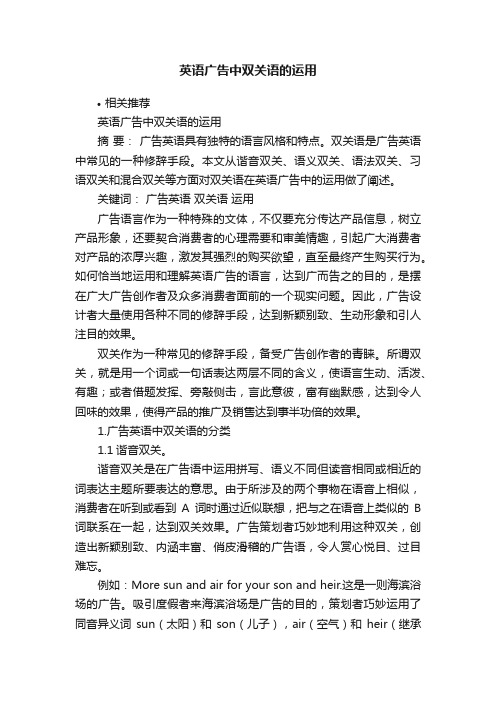
英语广告中双关语的运用•相关推荐英语广告中双关语的运用摘要:广告英语具有独特的语言风格和特点。
双关语是广告英语中常见的一种修辞手段。
本文从谐音双关、语义双关、语法双关、习语双关和混合双关等方面对双关语在英语广告中的运用做了阐述。
关键词:广告英语双关语运用广告语言作为一种特殊的文体,不仅要充分传达产品信息,树立产品形象,还要契合消费者的心理需要和审美情趣,引起广大消费者对产品的浓厚兴趣,激发其强烈的购买欲望,直至最终产生购买行为。
如何恰当地运用和理解英语广告的语言,达到广而告之的目的,是摆在广大广告创作者及众多消费者面前的一个现实问题。
因此,广告设计者大量使用各种不同的修辞手段,达到新颖别致、生动形象和引人注目的效果。
双关作为一种常见的修辞手段,备受广告创作者的青睐。
所谓双关,就是用一个词或一句话表达两层不同的含义,使语言生动、活泼、有趣;或者借题发挥、旁敲侧击,言此意彼,富有幽默感,达到令人回味的效果,使得产品的推广及销售达到事半功倍的效果。
1.广告英语中双关语的分类1.1谐音双关。
谐音双关是在广告语中运用拼写、语义不同但读音相同或相近的词表达主题所要表达的意思。
由于所涉及的两个事物在语音上相似,消费者在听到或看到A词时通过近似联想,把与之在语音上类似的B 词联系在一起,达到双关效果。
广告策划者巧妙地利用这种双关,创造出新颖别致、内涵丰富、俏皮滑稽的广告语,令人赏心悦目、过目难忘。
例如:More sun and air for your son and heir.这是一则海滨浴场的广告。
吸引度假者来海滨浴场是广告的目的,策划者巧妙运用了同音异义词sun(太阳)和son(儿子),air(空气)和heir(继承人),朗朗上口,极易使父母产生共鸣,携全家赴海滨度假。
又如:Catch the Raincheetah and cheat the rain.这是加拿大的一则雨衣广告。
Raincheetah是雨衣的牌子,它与raincheater同音。
谈双关语在英语广告中的运用及翻译

谈双关语在英语广告中的运用及翻译
秦莉丽
【期刊名称】《中国商界》
【年(卷),期】2010(0)12X
【摘要】双关语是广告中一种常见的修辞手段,它能够充分突出广告的特点,从而能够吸引消费者。
广告中双关语的翻译非常复杂。
双关语在广告翻译中有以下几个主要类型:语音双关、语义双关、语法双关和成语、俗语双关等。
同时从双关语内在的双重含义及广告语体风格考虑,双关语的汉译可以采用分别表义法、套译法、侧重译法和补偿译法等方法。
【总页数】2页(P299-300)
【关键词】双关;英语广告;翻译
【作者】秦莉丽
【作者单位】江苏经贸职业技术学院应用外语系
【正文语种】中文
【中图分类】H315.9
【相关文献】
1.英语广告中双关语的运用技巧及翻译 [J], 曾庆瑜
2.茶叶平面广告中双关语的运用及英语翻译技巧 [J], 甄宏伟
3.浅析英语广告中双关语的运用及翻译 [J], 凌淼峰
4.英语广告中双关语的运用技巧及翻译 [J], 田雨薇
5.英语广告中双关语的运用技巧翻译 [J], 张睿
因版权原因,仅展示原文概要,查看原文内容请购买。
- 1、下载文档前请自行甄别文档内容的完整性,平台不提供额外的编辑、内容补充、找答案等附加服务。
- 2、"仅部分预览"的文档,不可在线预览部分如存在完整性等问题,可反馈申请退款(可完整预览的文档不适用该条件!)。
- 3、如文档侵犯您的权益,请联系客服反馈,我们会尽快为您处理(人工客服工作时间:9:00-18:30)。
无独有偶, 可口可乐公司也在这个 can 字上做文章: Coke refreshes you like no other can. 没有什么能像可乐那样令您 神清气爽。 句中 can 既可理解为名词“罐, 听”, 又可看成是情态动词“能”, 全 句可理解为 Coke refreshes you like no other drink can refresh you。这 则广告诙谐机智, 富于文字情趣, 能使商品连同这一广告词一起久久 印在读者记忆里。 4.成语或俗语双关 广 告 语 言 特 别 善 于 引 用 一 些 人 们 耳 熟 能 详 的 成 语 或 俗 语 。这 些 广 告以人们原有的社会、文化知识为基础, 以鲜明、独特的语言形式形成 双关, 既增强了广告的吸引力, 又体现了广告语言的艺术性, 更使广告 具有令人回味的弦外之音。 (1)You’ll go nuts for the nuts you get in Nux.纳克斯坚果让你爱不 释口。 从广告的字面意义看, to go nuts 是 “去 买 坚 果 ”, 但 它 同 时 还 是 一 句成语, 意为“疯狂、发疯”, 所以此句还含有“Nux 坚果会令你发狂”的 意思。双关语的运用表明了纳克斯牌坚果有着令人无法抗拒的诱惑。 (2)Better late than the late. 这一妙句出自成语“Better late than never”( 晚来总比不来好) 。它 妙就妙在不仅引用了成语的结构, 还利用了 late 的双关意义, the late
1.语音双关
语 音 双 关 是 借 助 发 音 相 同 或 相 近 的 词 构 成 的 双 关 形 式 。此 类 双 关 具有风趣、幽默、俏皮、滑稽的 语 言 风 格, 能 增 强 广 告 的 说 服 力 和 感 染 力, 从而给消费者留下深刻的印象。
(1)More sun and air for your son and heir. 这 里 有 充 足 的 阳 光, 清 新的空气, 一切为了您的子孙后代。
【关键词】双关语; 英语广告; 广告语言 Application of Puns in English Adver tisements Yanweiqiang
(Inter national Office of Zaozhuang Univer sity, Zaozhuang, Shandong, 277160) 【Abstr act】Pun is one of the most frequently used rhetorical devices in English advertisements. It has the ability to make the advertising language more interesting and more humorous, which is helpful to attract the would- be consumers attention and promote the purchasing action. 【Key wor ds】pun ; English advertisements; advertising language
这 则 广 告 中 WEAR- EVER 为 其 品 牌 名 称, 该 词 与 wherever 发 音 相同, 含蓄地说明该产品到处受人欢迎。另一方面该词又另有含义, 可 以理解为 wear forever, 体现其结实耐用的良好特点。可以看出, 该广告 从多角度推销其产品, 有助于激起顾客的购买欲望, 具E & TECHNOLOGY INFORMATION
2008 年 第 7 期
浅谈广告英语中双关语的运用
颜伟强 ( 枣庄学院国际合作与交流处 山东 枣庄 277160)
【摘 要】双关作为一种常见修辞手段, 在广告中的应用也比较频繁, 它不仅能增加广告的趣味性和幽默感, 更重要的是使广告更能吸引人 们的注意力, 便于记忆, 增加宣传攻势力度, 以此达到宣传产品的目的。本文主要从语音、语义、语法等层面探析了双关语在现代英语广告中的 运用。
英语 paronomasia(双关)俗称 Pun, 是英语修辞中一种常见的形式。 Webster’s Third New International Dictionary 对双关所作的的解释 是 : the humorous use of a word in such a way as to suggest different meanings or applications of words having the same or nearly the same sound but different meanings; a play on words. 由此可见双关 实 为 一 种 有趣的文字游戏, 该修辞格巧妙地利用词的谐音、多义或歧义等,在 同 一 句 话 里 同 时 表 达 不 同 的 意 义,以 形 成 语 言 生 动 活 泼 、幽 默 诙 谐 的 修 辞效果。作为一种修辞手段, 双关语在广告中比较常用, 它存在于语 音 、词 汇 、句 法 等 各 个 语 言 层 面 。双 关 语 不 仅 能 增 加 广 告 的 趣 味 性 和 幽 默感, 更重要的是使广告更能吸引人们的注意力, 便于记忆, 增加宣传 攻势力度, 以此达到宣传产品的目的。广告作者抓住品牌的特点, 运用 高超的语言技巧, 匠心独具地利用同音或语义的联系, 使之形在此而 意在彼, 增强语言幽默感, 吸引消费者注意力, 增强广告宣传效果。 双 关 的 构 成 形 式 主 要 有 语 音 双 关 、语 义 双 关 、语 法 双 关 及 成 语 双 关 。这 些形式在英语广告中都得到了不同程度的运用, 以下我们将分别对其 进行简单的介绍。
在 这 则 海 滨 浴 场 的 宣 传 广 告 中, 制 作 者 巧 妙 地 运 用 了 sun- son, air- heir 这两对谐音字, 使广告语言不仅和谐悦耳, 读来琅琅上口, 而 且颇风趣、幽默, 具有感召力。
(2)WEAR - EVER introduces a new concept in glass oven ware: CLEAN ABILITY. “恒久”玻璃炉具带给你一个全新的概念: 洁净。
260
科技信息
○外语教研○
SCIENCE & TECHNOLOGY INFORMATION
2008 年 第 7 期
This can.( 旁边画有一罐啤酒) 哪种大罐啤酒可称得上是地道的德 国货? 这罐。
这是一则 Lager 牌淡啤酒的广告。句中的 can 既可作情态动词, 又 可作名词( 饮料罐) 。由于 can 一语双关, 加上 Lager 的品牌名称双关, 以及旁边插图的妙用, 使广告产生了一定的幽默效果, 给读者以深刻 的印象。
音,似 乎 在 传 递 一 种 “用 不 用 由 你 ”的 态 度 , 容 易 使 人 联 想 起 汉 语 中 的 “信不信由你”。看上去是把选择权交给了消费者, 但实际上却体现出 了 对 自 己 产 品 的 极 大 自 信— — — “你 一 定 会 买 的 ”。
2.语义双关
语义双关是利用词语或句子的多义性在特定环境下形成的双关。 语义双关是言在此而义在彼, 造成一种含蓄、委婉, 耐人寻味的意境, 增强语言的表达效果, 激发消费者的好奇心, 从而产生购买欲望。
(1)Spoil yourself and not your figure. 尽情大吃, 不增体重。 这是 Weigh t- Watcher 冰淇淋的广告, 这种冰淇淋是专为节食者 生产的。该广告中的 spoil 一词体现了双关的用法。spoil oneself 意为 “尽兴”; 而 spoil one’s figure 则意为“破 坏 体 形 ”。 这 则 广 告 通 过 一 语 双关, 可以使减肥者在轻松幽默的语气中很自然地接受它, 并能对产 品产生购买欲望。 ( 2) Are you still using soap to clean your face? CETAPHIL beats soap face to face. 您还在用肥皂洗脸吗? CETAPHIL 当面击败肥皂。 这 是 是 CETAPHIL 洗 面 奶 的 广 告, 其 中 face to face 既 说 明 产 品 的用途, 又有当面击败的含义, 巧妙地运用了语义双关的修辞手法。该 广告词通过俏皮、可爱的话语向消费者传递着此品牌的特点, 同是消 费者也记下了“CETAPH IL ”这个洗面奶品牌的名称。 ( 3) I’m More satisfied. 摩尔香烟, 我更满意 Ask for More. 再来一支, 还吸摩尔 这 是 摩 尔 香 烟 在 广 告 语 中 树 立 的 两 个 双 关 典 范 。它 们 巧 妙 地 使 用 more 一 词 的 双 重 意 义 : more 是 一 个 副 词 , 表 示 “更 加 , 更 多 ”; 大 写 之 后, 变成了品牌名称。这两则广告使人们轻松记住了商品的品牌, 同时 又给人留下了一个印象: 该产品优于同类产品, 能使消费者更加满意。 ( 4) Give your hair a touch of spring. 给你的头发一缕春色(一丝弹 性)。 这 则 洗 发 水 广 告 里 的 Spring 既 指 春 色 , 又 指 头 发 的 弹 性,充 分 展 示了该产品的优点。 ( 5) The driver is safer when the road is dry. The road is safer when the driver is dry. 这则宣传交通安全的广告运用了 dry 一词的两重词义( 干燥的/没 饮酒的) 构成双关, 对司机很有警示作用。dry 一词的两重意义在上、下 句中只能各取一意: 路面干燥, 司机安全; 司机清醒, 道路安全。 (6)Every kid should have an Apple after school. (苹果电脑广告) 标 题 中 的 “have an App le”是 一 个 同 形 异 义 的 语 义 双 关, 它 利 用 与 商 品 名 称 “Apple”同 名 的 健 康 水 果 “apple”(苹 果) , 建 议 儿 童:“放 学 回家后除了要吃一个苹果, 还要拥有一台‘苹果’牌电脑”。 ( 7) The Unique Spirit of Canada. ( 加拿大酒广告) 别具风味的加拿 大酒, 独特的加拿大精神。 spirit 一词是传神之作, 它既可作“烈性酒”解, 又可作“精神”解。 3.语法双关 语法双关是指由于语法方面的问题产生的双关, 如省略结构、某 词或词组具有两种以上语法功能等。例如: Which lager can claim to be truly German?
